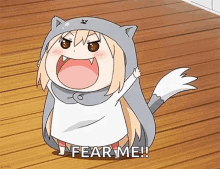I'm not sure that using one layer would make things take longer for me (I'm very slow as it is) but having layers gives me a lot more flexibility to change my mind about something I did many steps ago. For instance, I'm not great at shading, so I might finish a piece, then decide that I hate the shading, or that it's not right for where the light source ended up being (I tend to do backgrounds last so things sometimes change from how I was expecting them to be). If the shading is on its own layer, I can just start it over without affecting the flat colors or lines. Some of my layers will also be set to multiply, or add glow, etc. It's all about flexibility.
No, just one. I sketch on paper, so what goes into the computer is the line art.
I assume if that's actually a widespread issue, then most artists don't have a Recolor tool...? ^^; Because that's what I use for coloring: if the canvas is one color and the lines are another, they won't be touched.
It even works on transparencies, and with anti-aliasing (although not quite as well).
Multiple layers for things like shading, colors, lines, etc. mean that you can change one without affecting the other at all. For example, I can change the location of an eye without changing the location of the whole canvas.
Also, blending modes don't really work with one layer, so textures or anything related won't work
One last thing I want to add on, if exporting from illustrator to after effects, you need layers in order to animate stuff lol
Basically what everyone else said. I’d also like to add that its helpful for production folk to have things at separate layers in case there’s something that needs to be fixed or adjusted for print. It would be a huge headache for my publishers if I didn’t do my coloring separate from my lines.
This is also common with comics done in completely traditional media. Most of my friends who do it (myself as well when I was full traditional) will do their lines and then lightbox the coloring in a separate piece of paper, scan it, edit the lines to make em proper black, color correct the color layer, and then overlay the colors on top digitally. In case the proofs don’t print in a satisfactory way, its useful to be able to pinpoint an issue and fix it quickly with no fuss.
Okay, now I'm starting to think maybe this really is the reason...although a recolor tool doesn't sound like something that would be difficult to code; I don't see why most of the expensive art programs wouldn't have one.
And then, a lot of the other stuff I do is just masking...like, if I do the shading wrong and decide to redo it, I can just select all the shadow colors and revert them to base colors-- bam, we're back to flats.
Or I can select them and modify them with the hue slider...stuff you could probably do in any art program. =/
I get that it wouldn't be quite that simple with anti-aliasing involved...but I have done a little actual painting before, and even that I prefer to do all on one layer, because then if you don't like something you can just paint over it, or 'smudge it up' so it looks correct. Rather than having to flip through layers and redo an entire effect just to extend a shadow a little bit.
It makes it easier to layer, ha layer, things like shadows. Things won't get muddled together on one layer and you won't accidentally erase your shadows when doing your highlight. And then there's no picking a shadow color for every individual color in the drawing.
Edit:
Yea but with multiple layers, you can just delete the layer or clear the layer, and you get the same result. It's just a matter of process, you know.
As an add on, Multiple layers is really important for me because I like to color my lineart. It's just convenient to draw my lineart and come back later to color those lines on a separate, clipping layer.
i take joy and pride in making people uncomfortable with my obscene amounts of layers

also it's just easier to fix or edit stuff. i know there's tool or whatever in some programs but i like to keep things simple and organized. i'll absolutely merge things down if need be but i don't think i've ever just worked on a single layer unless i was doodling or something
Layers allow for a much more versatile, non destructive workflow. It's a lot easier to achieve complex, layered effects and lighting using multiple layers rather than a single one. I don't use as many layers as other artists I've seen, but a specific set of layers are essential to my pipeline. For instance, I'll have flats on one layer, then each light on a separate layer utilizing various blending modes, then shadow grading, scene light grading, then total scene tint to pull my palette into line. Inks go on top, then a folder of post effects like sparks, glow, fog, bloom, etc. above that, and final levels.
Layers are also just useful for splitting certain things out as I draw them. For instance, if I know certain inks are going to be color hold, like glass for instance, I'll split them out into a different layer as I'm drawing them. Then I can move that element around in my layer stack and recolor it as I see fit. Sometimes I'll lay down flats for various scene elements in different layers if I know I'll need to select an element later. For instance if I have a scene where there's a woman in the foreground against a foggy background, I'll put the woman in a different flats layer than the background flats so that I can just select the woman with a single click to mask out the fog in the post layers. Huge time saver if you're doing complicated stuff!
The smallest amount I'll use is 2 layers. 1 for lines and 1 for colors.
But I'll work with multiple layers until I get a sketch I like, then merge together, then put the lines in a layer above, then clear the sketch layer and use it as a color layer.
For me it was a RAM issue. My machine just couldn't handle a file over too many layers / pixels big. Even if it was a 1500x1500 300dpi image, it would eventually have a RAM issue due to too many layers. Now I have a decent rig and I just use folders (folder for sketch, folder for color, ect).
But yeah, I could do stuff on 1 layer, but I likely wouldn't color it lolololol because I don't have a tool to color it without destroying the lines.
I think it depends on the person and your background. I was originally a traditional painter so I used to only paint in one layer basically all the time. I don't do that digitally anymore, mostly for speed reasons and certain techniques (I can actually get really layer heavy if I'm just trying stuff out and messing around) but like...you can easily paint on one layer. Especially if you are going for a painterly look. In fact I'll often just straight up flatten my image when I'm painting if I feel like I have too many layers going.
For stuff like comics where you need font and bubbles I use a billion layers, but that's another story and that's more to preserve them so I can edit better.
I could make a landscape painting on one layer easily enough - it wouldn't look anywhere close to my best work, but if I planned out the steps I was going to take, it'd be possible.
But there's no way I could recreate my usual style with a single layer. I have so many glowy lights, and stars, and gradiating colours... I need my layer modes, and I need to be able to segregate and alpha-lock colours in order to shade the way I like to.
I do tend to work with way fewer layers than a lot of artists, especially given mine is a sci-fi comic which requires fancy layer modes for glow effects. That stems from using Procreate with large canvas sizes, since that app limits layers relative to canvas size, DPI and RAM. I have more wiggle room now, since I upgraded to a new iPad, but I still have to watch my layer use carefully.

 sometimes if I'm feeling really lazy, I'll have over 30 unlabeled layers (which is hell if I forget which layer is which)
sometimes if I'm feeling really lazy, I'll have over 30 unlabeled layers (which is hell if I forget which layer is which)


